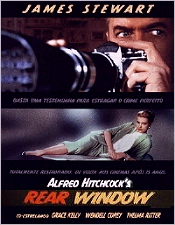 |
Rear WindowParamount |
|---|
 |
Rear WindowParamount |
|---|
|
James Stewart - L. B. 'Jeff' Jeffries Grace Kelly - Lisa Carol Fremont Wendell Corey - Lt. Thomas J. Doyle Thelma Ritter - Stella Raymond Burr - Lars Thorwald Judith Evelyn - Miss Lonelyheart |
Alfred Hitchcock - Director James C. Katz - Producer John Michael Hayes - Screenwriter Robert Burkes - Cinematographer Edith Head - Costume Design Franz Waxman - Film Score |
Based on the 1942 short story "It Had To Be Murder" by Cornell Woolrich, Rear Window (1954) earned director Alfred Hitchcock his fourth Best Director Oscar nomination and today stands as one of his most impressively "cinematic" suspense films--despite the fact that it was shot on a single set (Paramount's Stage 18). Ironically, Hitchcock's earlier film, Rope, also featured the "one-set" gimick (again a Manhattan apartment)--and the 1948 movie shaped up as one of the master director's more memorable failures. Undeterred, he attempted it a second time with Rear Window and brought back James Stewart, the star of Rope, to headline the new production.
Hitchcock briefly considered shooting the film on location in Greenwich Village, then decided to build the needed set on a Paramaount sound stage. To recreate the proper Lower Manhattan flavor, he sent four photographers there with instructions to shoot the Village from all angles, in all weather, and under all lighting conditions. At Paramount 50 men worked two months constructing the $75,000 set, which consisted of the facing backs of a number of apartment buildings. In addition to Stewart's apartment, many of the other apartments (seen from Stewart's window) also "worked" having been furnished to suit the character of their occupants.
Lighting the various sets became a problem, particularly during a shot of Stewart in the foreground as the camera focused on action taking place in the apartments across the courtyard. For one scene, Paramount had to employ every light that wasn't being used on the lot--in addition to lights borrowed from Columbia and MGM. The proper amount of light was finally attained, but the heat on the set was intense. "Suddenly, in the middle of it, the lights set off the sprinkler system," Stewart recalled. "Not just a section of it, but on all the stages, and we're not talking about little streams of water but torrents." All activity stopped as the set was plunged into wet darkness. But Hitchcock was unfazed. According to Stewart, "He sat there and told his assistant to get the sprinklers shut off and then to tell him when the rain was going to stop, but in the meantime to bring him an umbrella."
Grace Kelly co-starred as Stewart's elegant girlfriend; the actress was simultaneously offered top roles in On the Waterfront and Rear Window, and opted for the latter, having worked with Hitchcock previously on Dial M for Murder (1953) with Ray Milland. Kelly's life changed the following year, during production of another Hitchcock film (To Catch a Thief, 1955, co-starring Cary Grant), when she met Monaco's Prince Rainier, her future husband. Hitchcock took a keen interest in every aspect of production--even wardrobe. Preparing to shoot a scene of Kelly in a sheer nightgown, he eyed the actress and then called for costume designer Edith Head. "The bosom is not right," he told Head. "We're going to have to put something in there." In Kelly's dressing room Head told the acress that Hitchcock wanted her to put in falsies. Kelly though they would show. The two women instead began making adjustments to the nightgown itself--using no falsies. "When I walked out onto the set," Kelly later revealed, "Hitchcock said, 'See what a difference they make.'"
Rear Window became a huge hit. The million dollar movie premiered in August 1954, and by May 1956 had grossed $10 million. It also reaped four Academy Award nominations: Best Director, Screenplay, Cinematography and Sound. In addition, screenwriter John Michael Hayes won an Edgar Allan Poe award from the Mystery Writers of America for the screenplay. Its theatrical reissues were also resounding box-office successes. The songwriter in the apartment across the courtyard was played by real-life songwriter Ross Bagdasarian. Two of the party girls in that scene are played by future stars Kathryn Grant (Later Mrs. Bing Crosby) and Marla English. And watch for Alfred Hitchcock to make his cameo on that same set.
Franz Waxman's score for Rear Window is also interesting in that it employs only naturalistic music--jazz, pop, whatever is going on around the apartment block in which James Stewart is marooned with his leg in plaster. Rear Window is one of Hitchcock's greatest successes and may define his work better than any other single film, with the possible exception of North by Northwest (1959). In the 1998 TV remake of Rear Window, Christopher Reeve played the leading role, re-written to make him a newly paralized architect. It was Reeve's first role since the accident that caused his real-life paralysis. The actor earned a Screen Actors Guild Award and a Golden Globe nomination for his performance.
--from the collector's edition, widescreen
DVD release of Rear Window, Universal.
A selection of Rear Window related films.
|
Find Rear Window on eBay.com
A selection of Rear Window in books.
|
|
home: The Film Noir 'net |
back to: MODERN NOIR |
|
Any comments, additions or suggestions
should be addressed to: The Film Noir 'net / Eric B. Olsen / ericbolsen@juno.com |
Other Web Sites:
History of Horror Hard Bop Homepage The War Film Web Author Eric B. Olsen |